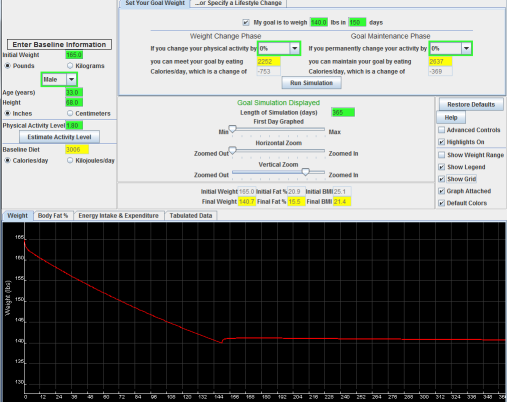Loved the tool. Very useful.
A New Equation to Calculate the Calories Required to Lose Weight
March 26 2012
How do you use an equation to calculate the calories required to lose weight? It is always said that you need to burn 3500 calories to burn one found of fat. Hence the usual logic is to cut 500 calories per day and you will be losing 1 lb a week. This is called the 3500 calorie per pound rule.

But this never happens in reality.
Why is the 3500C reduction to lose 1lb rule wrong?
Assumption: This calculation is based on the assumption that you are losing 87% of fat. But when people lose weight, they lose muscle mass too.
Metabolic Slow Down: As you lose weight, you also lose some muscle. This loss in muscle causes a decrease in resting metabolic rate.
Calories burned: As you lose weight, your body burns less calories to do the same amount of activity.
Starting Composition: It is now known that people with greater initial body fat levels lose less muscle compared to people with lower initial body fat levels.
How is the new equation different from the old equation?
Old equation: For a 224lb guy, a 500 calorie deficit/week will result in 50lb weight loss in the first year.
New equation: Based on the new model, for a 224lb guy, the body weight will plateau after losing 56 lbs in 10 years. Out of the 56 lbs, you will lose 22lb in the first year and the 95% of the this 56lb in 3 years.
The old equation predicts greater than 100% weight loss than the new equation!
What is this new dynamic equation?
These complex equations to calculate the calories required to lose weight have been integrated into a web-based program.
- Enter your current weight, height, age and activity level
- Enter your desired weight & duration you need to lose this weight
- Enter the increase in physical activity
- You will get the calories you should eat to reach this weight and the calories required to maintain this weight.
- There are a lot more features in the results, like body fatness, results in tabular form and so forth.

For example, I am 165lb and 68in tall. In the top-middle panel, I have my goal weight (140lb) and desired time interval to achieve the goal (150 days).Running the simulation shows the required changes of calorie intake to meet the goal and then maintain the weight change. The simulated bodyweight trajectory is graphically displayed in the lower panel. Users can also modify the physical activity tosee how combinations of diet and exercise can achieve the same goal.
Click the lick to open the body weight simulator: The New Equation
Limitations
- There is a 5% error in calculating the basal energy requirements
- The adherence is assumed to be perfect
- Changes in energy intake which can effect changes in energy expenditure. For example, people eating more after they work out
- There are genetic factors which can change the weight lost or gained.
Practical Application
- The old equation is static and clearly overestimates the predicted weight loss
- The new equation takes into account the loss in muscle mass and the drop in calorie expenditure with weight loss
- Though it has limitations, the new equation can predict the calories required or activity needed to lose a certain amount of weight in a certain duration with a greater accuracy than it has ever been possible.
Related Articles
Great article, Anoop.
However I don’t get how come:
“As you lose weight, your body burns less calories to do the same amount of activity.”
You mean if 80kg men walk, he spend more energy then 70kg men?
Anoop | Mon March 26, 2012
Thanks Gchussir!
Thanks Anatoly.Yep. The 70Kg will spend less energy than the 80kg because of the lower weight. Make sense?
The equation has been validated by looking at a few weight loss studies too.
MetroEast Beast | Mon March 26, 2012
Anoop,
Is this based on only a calorie elimination and or activity (walking, low impact). I’d imagine adding a well rounded strength and conditioning routine would nearly eliminate the lose of muscle mass.
Dave Goulart | Wed March 28, 2012
Is this stimulator just for weight loss. What if someone is trying to increase LBM? I am just wondering how to follow your Bodyfat % based on the stimulator with the change of body composition. Thank you.
Anoop | Wed March 28, 2012
Hi Rob,
You can select what activity you do from the drop down menu. It has option for leisure and work activities. There is an option for strenous activities several times a week.
That is a good point.It’s true that weight training can minimize the muscle loss. I don’t think you can eliminate completely. That’s largely why strength loss is almost inevitable on a diet. How much you would lose would depend on your body fat levels,genetics,diet composition and such. Cardiovascular activities can minimize muscle loss too.
It is just a better estimate. Would be good to see what you get. They have range for individual variations.
Hi Dave,
You can use it for weight gain. If you look at the results, you will see different tabs. If you click on tab named “Tabulated Data”,you can see the estimated muscle loss/body fat/BMI or gain in numbers.
You can clearly see how when you take more days to lose the same amount of weight, the muscle loss is much smaller.
I don’t know if the app overestimates calories burned by exercise or I simply don’t understand it.
At 70kg, there is a difference of 171 calories in the TDEE just by walking once per week :/
Anoop | Fri March 30, 2012
Hi Ghussir,
I am guessing they meant one to 3 times a week or just light activity.
Those are the typical Activity factors which are used for calculating Activity-induced thermogenesis when you calculare RMR.







